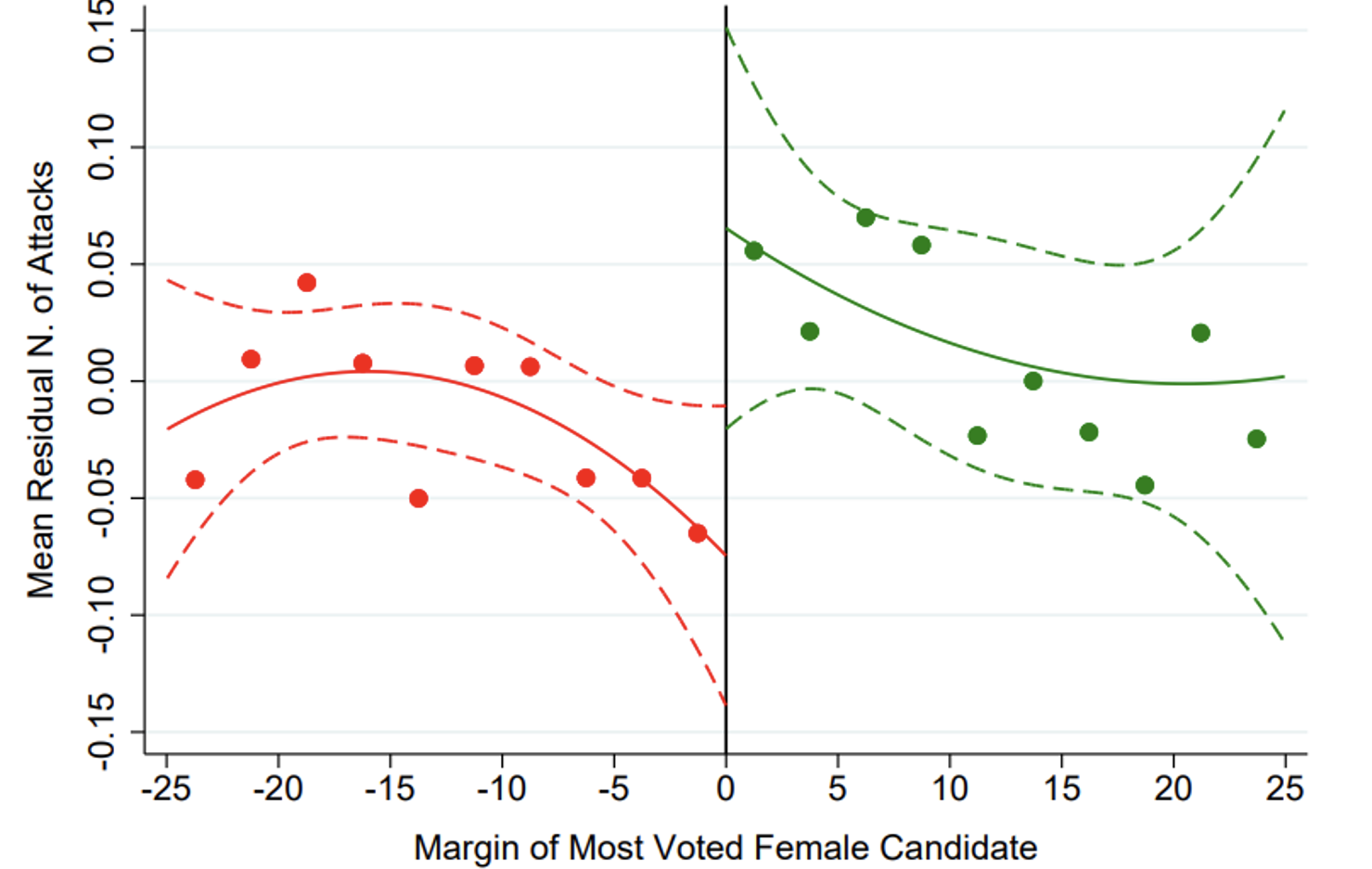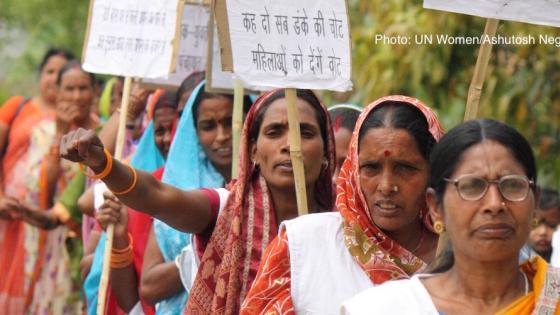Why does a gender gap persist in politics? Gender disparities have endured throughout history (Sinn and Nekoei 2021) across various sectors, including education (Card et al. 2023), high-skill industries (Ferrer and Azmat 2016), and healthcare (Dupas 2023). While female representation in politics has made significant strides, as of 2023, women occupy only a quarter of global parliamentary seats, and just 31 women hold leadership positions as heads of state or government among 195 countries.
The reasons behind women’s ongoing underrepresentation in the corridors of power are multifaceted and often complex to overcome. Research has explored factors from political parties sidelining women (Lawless and Pearson 2008, Folke and Rickne 2016, Huidobro and Falcó-Gimeno 2021) and voter discrimination (Teele et al. 2018), to cultural norms (Brulé and Gaikwad 2021, Robinson and Gottlieb 2021) and familial expectations (Iversen and Rosenbluth 2006, Prillaman 2023, Bernhard et al. 2021). In a recent study, we shed light on a significant material obstacle to women’s political participation: female politicians are more likely to become targets of physical and psychological violence while in office.
Women politicians are more likely to be victims of violence
Reports from international organisations have highlighted the disproportionate violence faced by women in the political arena compared to their male counterparts. Despite the seriousness of this issue, our grasp of the extent and underlying causes of violence against women in politics remains surprisingly limited. First, although recent studies (Håkansson 2021, Krook 2020, and Bardall et al. 2020) indicate that women are more frequently the targets of political violence, it is still unclear whether gender is causally connected to violence. Female politicians differ from their male colleagues on several dimensions other than gender. Therefore, women might be attacked more often because they are more likely to be younger, less connected, and more honest. Second, while qualitative research has begun exploring the institutional factors influencing violence against women in politics, we still lack a comprehensive, quantitative understanding of why female politicians are more subject to violence.
In a new paper (Daniele et al. 2023), we tackle these questions by leveraging 12 years of data on attacks against Italian politicians. We use data from the annual reports compiled by the NGO Avviso Pubblico. This organisation works closely with Italian local governments and provides a reputable source of information on both online and offline attacks against politicians, including verbal threats and physical violence.
The probability of an attack is three times higher for a female mayor
Our empirical strategy is based on a close-election regression discontinuity design and focuses on attacks on mayors, the highest political authority at the municipal level. Our approach estimates the differential in attacks across genders by comparing towns that elected a male mayor over a female challenger by a small margin of votes to those that elected a female mayor over a male challenger, again by a small margin. This allows us to ask whether marginally elected female mayors, similar in all respects to their male colleagues who barely lost, are more likely to be the targets of violence.
We show that female and male mayors marginally winning are similar across 16 characteristics. Our findings reveal that marginally elected women are approximately three times more likely to experience an attack (Figure 1). This result holds true even when accounting for potential variables such as unequal reporting of attacks across genders and other demographic factors.
Figure 1 Number of attacks after close mayoral election
Notes: The horizontal axis reports the electoral margin of victory: positive when a woman is elected; negative when a man wins.
Why are female politicians targeted more?
We explore the potential reasons behind this gender gap in violence. We consider two main explanations: first, that women may be targeted due to their gender identity and its associated implications for female empowerment; and second, that they may be targeted because of their policy choices. Our evidence strongly supports the first explanation, particularly in municipalities with higher levels of female representation.
Indeed, the gender gap in violence is driven by contexts in which the election of a female mayor coincides with relatively high levels of female representation across political institutions:
- Municipalities with an exogenously high share of female politicians because of gender quotas
- Municipalities with a high share of female councillors
- Municipalities with a growing share of female politicians over time
- Municipalities within regions governed by a female president
Interestingly, our research indicates that policy choices are not a significant factor in explaining the gender gap in attacks. We observe no notable differences in spending choices on sectors like healthcare, social welfare, and education between male and female mayors. Additionally, we find little evidence to suggest that female politicians are less prone to corruption compared to their male counterparts.
Violence convinces women to select out of politics
How does this disproportionate amount of violence affect the careers of female politicians? Our findings suggest that perpetrators use violence as a form of backlash to women’s political representation. Hence, their goal is likely to reduce the number of women in positions of power. The data indeed supports this interpretation. First, attacks are concentrated in municipalities with a female mayor not facing a term limit. Second, while female mayors are, generally, as likely as male mayors to run for re-election, those who have been attacked are significantly less likely to do so. This suggests that experiencing violence has a discouraging effect on female politicians, inducing them to self-select out of office.
From a policy perspective, by showing that female politicians are attacked regardless of their policy choices, our study implies that gender-based violence is a form of cultural backlash (Anduiza and Rico 2022), which is best tackled through educational interventions. In the shorter term, our findings highlight the importance of implementing effective public safety measures for newly elected women. Additionally, we advocate for institutional initiatives aimed at curbing the dispersion of female politicians who have suffered political violence, as gendered laws have proven effective in other contexts (Goldberg and Djankov 2021).
Our study points to several promising avenues for future research. These include exploring the relationship between political violence and facets of women’s policymaking styles, as well as examining the influence of public discourse on the frequency and intensity of attacks against female politicians.
References
Anduiza, E, and G Rico (2022), “Sexism, and the far-right vote: The individual dynamics of gender backlash”, American Journal of Political Science.
Bardall, G, E Bjarnegård, and J M Piscopo (2020), “How is political violence gendered? Disentangling motives, forms, and impacts”, Political Studies 68(4): 916–35.
Bernhard, R, S Shames, and D L Teele (2021), “To emerge? Breadwinning, motherhood, and women’s decisions to run for office”, American Political Science Review 115(2): 379–94.
Brulé, R, and N Gaikwad (2021), “Culture, capital, and the political economy gender gap: Evidence from Meghalaya’s matrilineal tribes”, Journal of Politics 83(3): 834–50.
Card, D, S DellaVigna, P Funk, and N Iriberri (2023), “Gender gaps at the academies”, VoxEU.org, 2 February.
Daniele, G, G Dipoppa, and M Pulejo (2023), “Attacking women or their policies? Understanding violence against women in politics”, CEPR Discussion Paper DP18333.
Dupas, P (2023), “Closing the gender gap in healthcare”, VoxEU.org, 26 July.
Ferrer, R, and G Azmat (2016), “Gender gaps in performance among high-skilled professionals”, VoxEU.org, 12 July.
Folke, O, and J Rickne (2016), “Electoral competition, and gender differences in political careers”, Quarterly Journal of Political Science 11(1): 59–102.
Håkansson, S (2021), “Do women pay a higher price for power? Gender bias in political violence in Sweden”, Journal of Politics 83(2): 515–31.
Huidobro, A, and A Falcó-Gimeno (2021), “Women who win but do not rule. The effect of gender in the formation of governments”, Journal of Politics, forthcoming.
Goldberg, P, and S Djankov (2021), “Gendered laws do matter”, VoxEU.org, 24 May,
Krook, M L (2020), Violence against women in politics, Springer.
Iversen, T, and F Rosenbluth (2006), “The political economy of gender: Explaining cross-national variation in the gender division of labor, and the gender voting gap”, American Journal of Political Science 50(1): 1–19.
Lawless, J L, and K Pearson (2008), “The primary reason for women’s underrepresentation? Reevaluating the conventional wisdom”, Journal of Politics 70(1): 67–82.
Prillaman, S A (2023), “Strength in numbers: How women’s groups close India’s political gender gap”, American Journal of Political Science 67(2): 390–410.
Robinson, A L, and J Gottlieb (2021), “How to close the gender gap in political participation: Lessons from matrilineal societies in Africa”, British Journal of Political Science 51(1): 68–92.
Sinn, F, and A Nekoei (2021), “The origin of the gender gap”, VoxEU.org, 27 May.
Teele, D L, J Kalla, and F Rosenbluth (2018), “The ties that double bind: Social roles, and women’s underrepresentation in politics”, American Political Science Review 112(3): 525–41.







